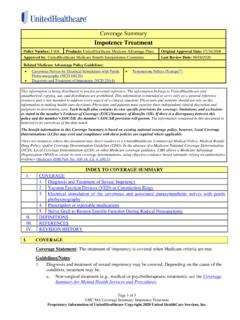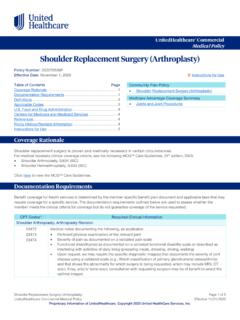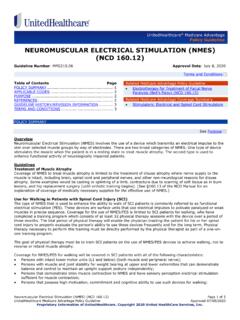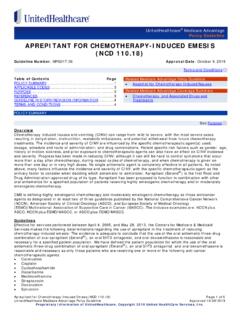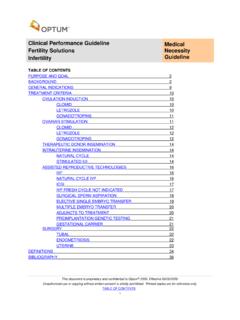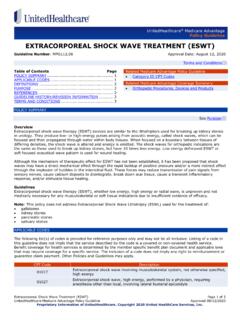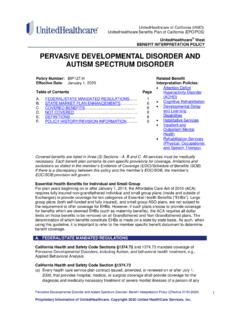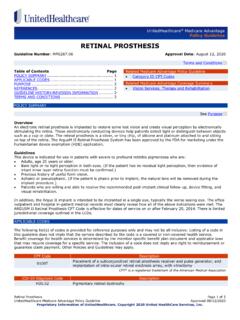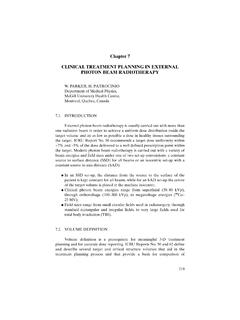Transcription of Sacroiliac Joint Interventions
1 UnitedHealthcare Commercial Medical Policy Sacroiliac Joint Interventions Policy Number: 2021T0621B. Effective Date: November 1, 2021 Instructions for Use Table of Contents Page Related Commercial Policies Coverage Rationale .. 1 Ablative Treatment for Spinal Pain Documentation Requirements .. 2 Epidural Steroid Injections for Spinal Pain Definitions .. 2. Facet Joint Injections for Spinal Pain Applicable Codes .. 3. Description of Services .. 3 Community Plan Policy Clinical Evidence .. 4 Sacroiliac Joint Interventions Food and Drug Administration .. 8. References .. 8. Policy History/Revision Information .. 9. Instructions for Use .. 10. Coverage Rationale Note: This policy addresses intraarticular Sacroiliac Joint injections and Fusion. This policy does not address radiofrequency ablation of the Sacroiliac Joint . For coverage criteria regarding radiofrequency ablation of the Sacroiliac Joint , refer to the policy titled Ablative Treatment for Spinal Pain.
2 Sacroiliac Joint (SI) injections are proven and medically necessary in certain circumstances. For medical necessity clinical coverage criteria, refer to the InterQual Client Defined 2021, CP: Procedures, Sacroiliac (SI) Joint Interventions (Custom) - UHG. Click here to view the InterQual criteria. Open Sacroiliac Joint Fusion is proven and medically necessary for treating the following indications: Traumatic injuries ( , pelvic ring fracture, acetabular fracture, spinopelvic dissociation). Sacral tumors when used as an adjunct to sacrectomy or partial sacrectomy Sacroiliac Joint infection when used as an adjunct to the medical treatment As part of multisegment spinal constructs extending to the ilium Painful degenerative Joint disease when the same criteria for Minimally Invasive Sacroiliac Joint Fusion are met For medical necessity clinical coverage criteria refer to InterQual Client Defined 2021, CP: Procedures, Sacroiliac (SI) Joint Interventions (Custom) UHG.
3 Click here to view the InterQual criteria Minimally Invasive Joint fusion using a Titanium Triangular Implant for treating painful degenerative Joint disease is proven and medically necessary when criteria are met. For medical necessity clinical coverage criteria, refer to InterQual Client Defined 2021, CP: Procedures, Sacroiliac (SI) Joint Interventions (Custom) UHG. Click here to view the InterQual criteria. Sacroiliac Joint Interventions Page 1 of 10. UnitedHealthcare Commercial Medical Policy Effective 11/01/2021. Proprietary Information of UnitedHealthcare. Copyright 2021 United HealthCare Services, Inc. Open Sacroiliac Joint Fusion is unproven and not medically necessary for all other indications not listed above due to insufficient evidence of efficacy. Minimally Invasive Sacroiliac Joint Fusion is unproven and not medically necessary for all other conditions not listed above due to insufficient evidence of efficacy.
4 Documentation Requirements Benefit coverage for health services is determined by the member specific benefit plan document and applicable laws that may require coverage for a specific service. The documentation requirements outlined below are used to assess whether the member meets the clinical criteria for coverage but do not guarantee coverage of the service requested. CPT Codes* Required Clinical Information Sacroiliac Joint Interventions 27279 For Sacroiliac Joint Fusion provide medical notes documenting the following, when applicable: 27280 Condition requiring procedure 64451 History and co-morbid medical condition(s), including presence or absence of somatoform disorder G0260 or generalized pain disorders Member's symptoms including pain, location, and severity Physical exam, including: o Specific location of tenderness o Results of at least three of these five tests: Compression test Distraction test FABER test (also referred to as Patrick's test).
5 Gaenslen's test Thigh thrust test (also referred to as posterior pelvic pain provocation). Reports of all recent imaging studies and applicable diagnostics Treatments tried, failed, or contraindicated; include the dates and reason for discontinuation Results of the fluoroscopically guided diagnostic intra-articular SIJ block using local anesthetic *For code descriptions, refer to the Applicable Codes section. Definitions Arthrodesis: The surgical fixation of a Joint to promote bone fusion; also called artificial ankylosis or syndesis. Axial Skeleton: In the human body , the bones of the body axis, including the skull, vertebral column, ribs, and sternum. Titanium Triangular Implant: A Sacroiliac Joint (SIJ) implant ( , iFuse Implant System ) intended for treating low-back pain associated with SIJ dysfunction. The system comes with surgical instruments for implant placement during minimally invasive surgery (MIS) performed through a 2 to 3 cm incision, and three titanium implants are placed in the SIJ using a cannulated delivery system intended to protect soft tissue.
6 The implants are available in 30 to 70 mm lengths and in two different diameters: 4 or 7 mm. Minimally Invasive Procedure: A surgical procedure that is done under direct or indirect visualization, the intention of which is to minimize surrounding tissue damage and disruption through the use of specialized technological aids. Percutaneous: A Percutaneous surgical procedure contrasts with an open surgical procedure in that the size of the skin incision is minimized through the use of technological aids. Provocative Tests: Physical examination maneuvers intended to provoke pain in order to localize the pain generator. Five different physical tests that provoke SI Joint Pain positions include: thigh thrust test, compression test, Gaenslen's test, distraction test, Patrick's sign. (NASS, 2015). Sacroiliac Joint Interventions Page 2 of 10. UnitedHealthcare Commercial Medical Policy Effective 11/01/2021. Proprietary Information of UnitedHealthcare.
7 Copyright 2021 United HealthCare Services, Inc. Sacroiliac Joint : The synovial Joint formed at the juncture of the sacrum and ilium. Sacroiliac Joint Fusion: Surgical technique that is intended to achieve bony fusion of the Sacroiliac Joint and stabilize it, thus reducing pain and disability. Sacroiliac Joint fusion may be performed as a Minimally Invasive Procedure or as an open surgical procedure. In the open procedure, bone grafts, obtained either from the patient or through the use of morselized bone product, may or may not be used. Percutaneous Sacroiliac Joint fusion is a minimally invasive approach in which pins screws or small bone-filled cages are placed percutaneously across the Joint space on one or both sides in order to achieve fusion. Sacroiliac Joint Pain: Pain originating from the Sacroiliac Joint and/or its supporting ligamentous structures as a result of injury, disease or surgery. Applicable Codes The following list(s) of procedure and/or diagnosis codes is provided for reference purposes only and may not be all inclusive.
8 Listing of a code in this policy does not imply that the service described by the code is a covered or non-covered health service. Benefit coverage for health services is determined by the member specific benefit plan document and applicable laws that may require coverage for a specific service. The inclusion of a code does not imply any right to reimbursement or guarantee claim payment. Other Policies and Guidelines may apply. CPT Code Description 27096 Injection procedure for Sacroiliac Joint , anesthetic/steroid, with image guidance (fluoroscopy or CT). including arthrography when performed 27279 Arthrodesis, Sacroiliac Joint , percutaneous or minimally invasive (indirect visualization), with image guidance, includes obtaining bone graft when performed, and placement of transfixing device 27280 Arthrodesis, open, Sacroiliac Joint , including obtaining bone graft, including instrumentation, when performed 64451 Injection(s), anesthetic agent(s) and/or steroid; nerves innervating the Sacroiliac Joint , with image guidance ( , fluoroscopy or computed tomography ).
9 CPT is a registered trademark of the American Medical Association HCPCS Code Description G0260 Injection procedure for Sacroiliac Joint ; provision of anesthetic, steroid and/or other therapeutic agent, with or without arthrography Description of Services Sacroiliac (SI) Joint Fusion is a surgical procedure, which fuses the iliac bone (pelvis) to the spine (sacrum) for stabilization. It is performed for a variety of conditions including trauma, infection, cancer, and spinal instability. Sacroiliac Joint Fusion may be performed as a minimally invasive procedure or as an open surgical procedure requiring a larger incision and subsequent increased recovery time. Percutaneous Sacroiliac Joint Fusion is a minimally invasive approach in which instrumentation involving cages or screws, with or without bone graft, are placed percutaneously in order to achieve a fusion. Fusion of the Sacroiliac Joint , combined with bone grafts and other metal implant devices, is an extensive procedure; it is generally considered a salvage procedure when all other measures have failed to provide relief of pain.
10 Diagnosis of SIJ dysfunction is based on a combination of tests or provocative maneuvers during physical examination to help localize the pain to the SIJ. Imaging studies do not generally help to localize pain but can be used to exclude other diagnoses that may mimic SIJ pain ( , hip osteoarthritis, spine degeneration at the L5/S1 level, spinal stenosis). The physical examination may include Provocative tests ( , Gaenslen's maneuver, Patrick's test, thigh thrust, and compression and distraction tests) to stress the SIJ and reproduce the patient's pain. (Hayes, 2020, Foley and Buschbacher, 2006; Hooten and Cohen, 2015, Lorio, 2016). Sacroiliac Joint Interventions Page 3 of 10. UnitedHealthcare Commercial Medical Policy Effective 11/01/2021. Proprietary Information of UnitedHealthcare. Copyright 2021 United HealthCare Services, Inc. Clinical Evidence Open Sacroiliac Joint Fusion Surgical management of primary sacral tumors is challenging because of their size and location.
